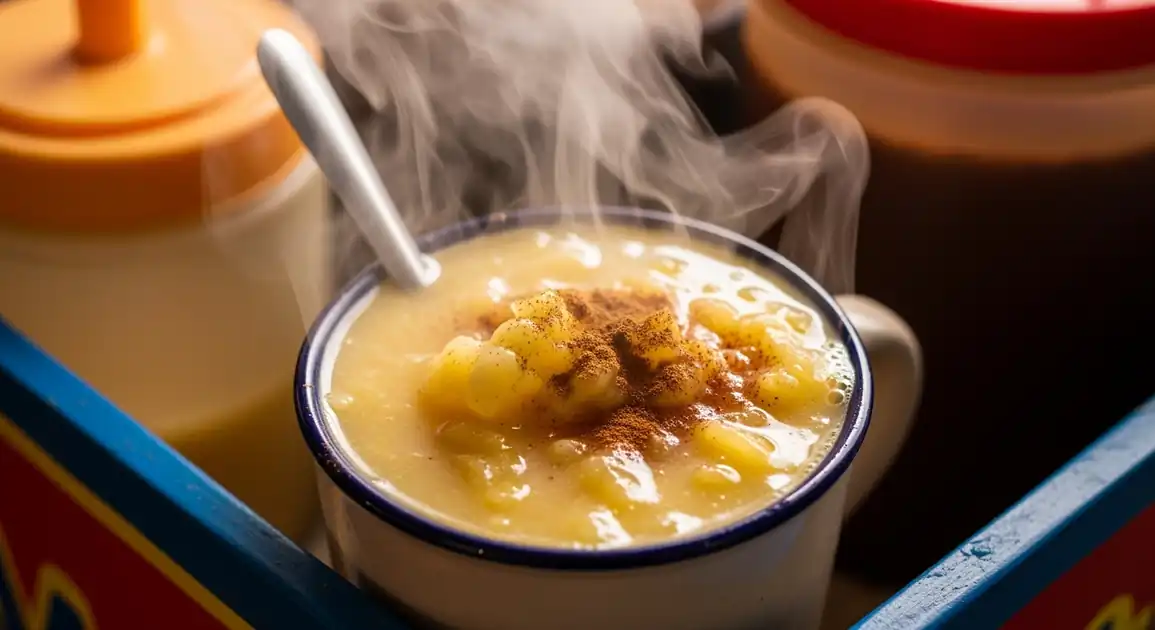Champús (Peruvian Fruity Corn Beverage)
Champús

Description
Champús is a well-loved traditional beverage found primarily in Lima and some coastal regions of Peru. It's strongly associated with street food culture, especially during the winter months (June-September), providing warmth and sustenance. While most common from street carts, it can sometimes be found in markets and traditional eateries.
Dietary Information
Serving information
Serving style
Served hot in disposable cups (paper or styrofoam) or sometimes simple mugs/bowls. Usually comes with a plastic spoon. Often garnished with a sprinkle of ground cinnamon on top.
Quick facts
Typically from mid-afternoon (around 3 PM or 4 PM) until evening (around 9 PM or 10 PM).
Safety Tips
What to Look For
-
Served piping hot with visible steam
Ensures the beverage is held at a temperature that inhibits bacterial growth and is authentic to how it's traditionally served.
-
Clean vendor station, pot, and utensils
General cleanliness indicates better hygiene practices, reducing contamination risk.
-
High customer turnover
A busy vendor usually means the Champús is fresh and hasn't been sitting for an excessively long time.
-
Fresh appearance and aroma
The Champús should smell fruity and spiced, not sour or fermented. Fruit pieces (like mote) should look fresh.
What to avoid
-
Lukewarm Champús
Temperatures below piping hot can allow bacteria to multiply. Insist on hot servings.
-
Dirty pots, ladles, or serving cups
Obvious sign of poor hygiene standards and potential for contamination.
-
Vendors using questionable water sources (if visible)
Although hard to assess, avoid vendors if their water handling seems unsanitary.
-
Champús that looks dull, separated, or smells sour/fermented
Indicates the product might be old or improperly prepared.
Price information
Price range
Budget tips
- Street vendor prices are typically the lowest (3-5 PEN per cup).
- Prices in established markets or restaurants might be slightly higher.
- Look for vendors frequented by locals for fair pricing.
Value indicators
- Served piping hot.
- Good balance of fruit flavor, sweetness, and spice.
- Generous amount of mote.
- Clean vendor setup.
Where to Find This Dish
Busy Street Corners
Vendors often set up at intersections or areas with high foot traffic in various districts.
Commercial streets, Near bus stops ('paraderos')
Afternoon, Evening
Market Surroundings
Areas around traditional markets often attract street food vendors, including those selling Champús.
Outside Mercado Central, Mercado Surquillo (Lima)
Afternoon, Evening
Plazas and Parks
Sometimes found in or near public squares, especially during evenings or weekends.
Plaza San Martín (Lima), Local district plazas
Evening, Weekends
Vendor Tips
- Vendors often appear around the same time each day, usually late afternoon onwards.
- Look for the characteristic large, steaming pot.
- Specify cup size if options are available ('pequeño' or 'grande').
How to Order
Regional Variations
-
Champús de Trigo
(Champús de Trigo)
A variation using wheat grains instead of, or in addition to, mote (corn).
-
Fruit Variations
(Variaciones de Fruta)
While guanábana, pineapple, and quince are classic, some vendors might add other fruits like apples ('manzana') or pears ('pera').
-
Sweetness Level
(Nivel de Dulzor)
Sweetness can vary significantly between vendors based on the amount of sugar or chancaca used.
-
Thickness Variation
(Variación de Espesor)
Some prefer a thicker, spoonable Champús, while others make it slightly more liquid, depending on the amount of thickener used.
Cultural context
History
The origins of Champús are debated, with some tracing it back to pre-Columbian times, utilizing native corn and fruits. The name might have African roots, possibly adapted over colonial times. It became deeply embedded in Lima's street food culture ('comida de carretilla'), particularly associated with Afro-Peruvian traditions and neighborhood vendors ('champuceras') who prepared and sold it, offering warmth during the city's damp 'garúa' season.
Local significance
Champús is a comforting taste of home for many Peruvians, strongly associated with Lima's street food identity and providing warmth during the 'garúa' (misty drizzle) season.
Eating customs
- Consumed warm, sipping directly or using a spoon.
- Often enjoyed while standing near the vendor's cart or walking.